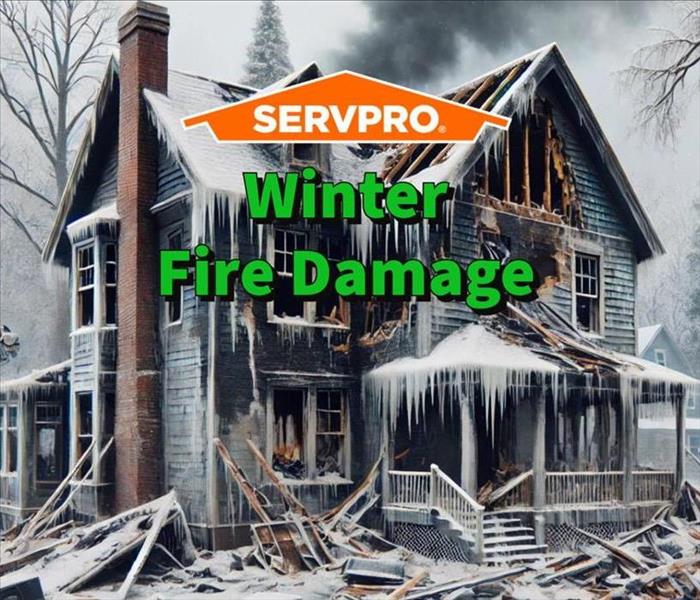Winter Fire Damage: 5 Effective Tips to Safeguard Property
1/27/2025 (Permalink)
This comprehensive winter fire damage guide offers expert insights and practical strategies to protect your property from fire-related risks during colder months.
The winter season brings frigid temperatures and an increased reliance on heating systems, presenting unique fire hazards for property owners. Winter fire damage can pose significant threats to residential and commercial properties, making it crucial to understand its causes and prevention measures.
In this blog post, we will explore the common causes of winter fire damage, provide actionable prevention tips, and highlight how SERVPRO® expertise can be instrumental in restoring properties affected by seasonal fires.
What are the common causes of winter fire damage?
Winter fire damage is often caused by seasonal factors unique to the colder months. Key contributors include:
- Heating equipment malfunctions: Space heaters, furnaces, and fireplaces can overheat, malfunction, or cause flammable materials nearby to ignite.
- Electrical overloads: Increased use of heating appliances and holiday lighting can strain electrical systems, leading to short circuits and electrical fires.
- Candles and decorations: If left unattended, decorative candles and holiday lights can ignite nearby flammable objects.
- Cooking mishaps: With more time spent indoors, kitchen fires become a leading cause of winter fire incidents.
- Blocked chimneys: Soot and debris accumulation in chimneys can cause dangerous chimney fires if not properly maintained.
How can heating systems lead to property damage?
While essential in winter, heating systems can also be a major fire hazard if not properly maintained. Furnaces, space heaters, and fireplaces can cause fires due to overheating, electrical faults, or contact with flammable materials. Failure to clean chimneys and air ducts can result in the buildup of flammable residues, increasing the risk of fire.
Additionally, portable heaters should never be left unattended or placed near curtains, bedding, or furniture, as they can quickly ignite nearby objects.
Tips to prevent winter fire damage
Preventing winter fire damage requires proactive measures and vigilance. Here are practical steps to safeguard your property:
- Inspect heating systems: Have your heating systems, including furnaces, fireplaces, and chimneys, inspected and cleaned annually.
- Practice safe heating habits: Keep space heaters away from flammable materials and always turn them off when leaving the room.
- Install smoke alarms: Ensure working smoke alarms are installed in every room and test them monthly.
- Avoid overloading outlets: Use surge protectors and avoid plugging too many appliances into one outlet to prevent electrical fires.
- Use flame-resistant decorations: Choose holiday decorations that are flame-resistant or flame-retardant.
- Monitor candles closely: Never leave burning candles unattended; keep them away from flammable materials.
- Keep fire extinguishers handy: Place fire extinguishers in key areas like the kitchen and near heating appliances.
- Create an emergency plan: Ensure everyone in the household or workplace knows the fire escape plan and emergency contacts.
- Dispose of ashes safely: Allow fireplace ashes to cool completely before disposing them in a metal container away from the home.
Following these steps can significantly reduce the risk of fire damage and enhance property safety.
A recent winter fire damage case in Dayton, Ohio
Last winter, in Dayton, Ohio, SERVPRO responded to an urgent call from a local homeowner facing severe fire damage. A space heater left too close to the drapes had ignited, causing a fire that quickly spread through the living room. The homeowner contacted our SERVPRO team, and we promptly arrived on-site to assess the situation and implement our proven restoration process.
Our strategic action plan included:
- Fire damage assessment: We thoroughly inspected the extent of structural damage and smoke residue.
- Smoke and soot removal: We meticulously removed smoke and soot from surfaces and air ducts using advanced cleaning techniques and equipment.
- Odor elimination: Specialized deodorization techniques were applied to remove lingering smoke odors.
- Content restoration: We salvaged and restored valuable belongings affected by the fire.
- Final restoration: We rebuilt damaged areas and implemented fire prevention measures to avoid future incidents.
This incident in Dayton, Ohio, underscores the importance of fire safety measures and highlights SERVPRO's ability to respond swiftly and effectively to fire emergencies.
What should you do when you experience winter fire damage?
If you experience winter fire damage, taking immediate action is crucial to mitigate further loss. Here are the essential steps to follow:
- Ensure safety: Evacuate everyone from the premises and contact emergency services if needed.
- Contact SERVPRO: Our professional fire restoration team will respond quickly to assess and address the damage.
- Avoid DIY cleanup: Fire damage restoration requires specialized equipment and techniques to prevent further damage and contamination.
- Document the damage: Take photos and keep records for insurance claims.
- Stay informed: Work with professionals to understand the full scope of restoration needed.
Wrapping up
SERVPRO is your trusted partner in fire damage restoration, offering rapid response times, industry-leading expertise, and state-of-the-art equipment. Our experienced team understands the complexities of fire damage restoration, especially during the challenging winter months.
By choosing SERVPRO, property owners gain more than just restoration services; they receive peace of mind knowing their property is in expert hands. Winter fire damage can be devastating, but with the right preparation and SERVPRO by your side, you can confidently navigate the season's challenges.
For professional winter fire damage restoration in Dayton, Ohio, and surrounding areas, trust SERVPRO to restore your property and peace of mind.



 24/7 Emergency Service
24/7 Emergency Service